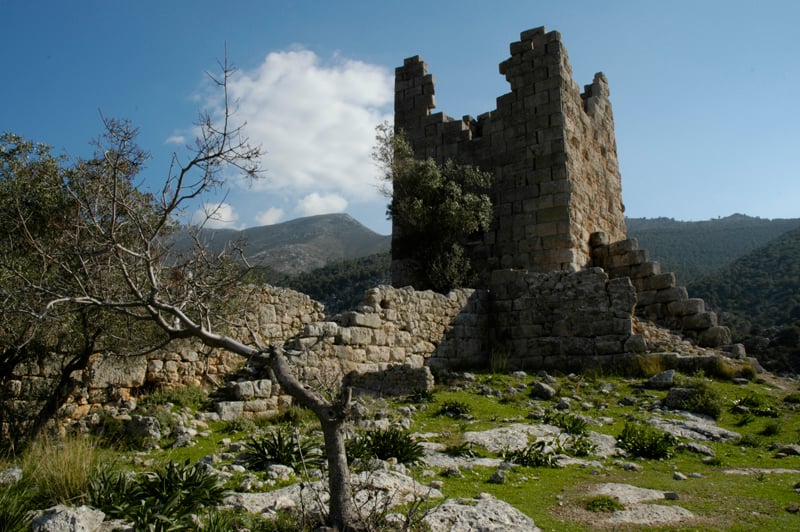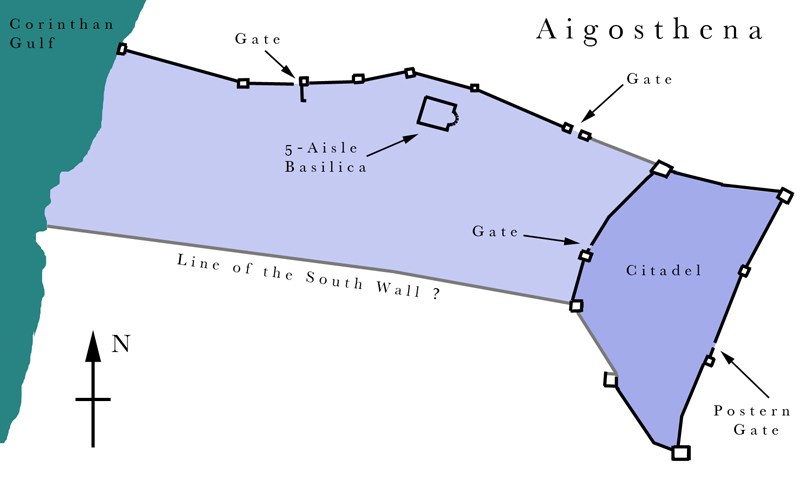
The ancient Fortress of Aigosthena at Porto Germeno in West Attica built in the second half of the 4th century BC, is one of the most imposing ancient military installations in Greece.
It has now been extensively and painstakingly restored after the earthquake that occurred at the nearby Alkyonides islands in the Gulf of Corinth back in 1981.
Constructed at the foot of Mt. Cithaeron, its stone walls extend all the way down to the sea at the inlet of Aigosthena on the east side of the Gulf of Corinth just 48 km (30 miles) from Athens.
Aigosthena was an ancient Greek fortified port city of Megaris, located 19 km (12 miles) northwest of the ancient city of Megara to which it belonged. It is also the name of the coastal village at the foot of the ancient city walls, also known as Porto Germeno.
The ancient citadel is famous for retaining several of the tallest surviving towers from the time of ancient Greece.
The ancient site of Aigosthena consisted of a fortified citadel connected to the sea by two fortification walls; the fortress consisted of the acropolis citadel and the lower town. The acropolis stands on a low hill just 450 meters (.2 of a mile) from the sea. Rectangular in shape, it is surrounded by a circuit wall with guard towers. The east side, which is preserved up to a great height, has four towers and a small postern gate.
The impressive tower at the southeast corner of the acropolis is the largest and tallest tower in the fortress. One of the most important examples of the ancient art of fortification, it is now fully restored and the interior with three floors and is open to the public.
Measuring roughly 90 by 187 meters (approximately 575 Doric feet), the citadel was roughly trapezoidal in plan with the narrower side at 113 meters (371 feet) long, It faces west toward the sea.
The acropolis was connected to the port by long walls, as can be seen from the air, although only the north wall survives today.
The northernmost of the two walls to the sea is well preserved, stretching 370 meters (1,213 feet) to a final tower of which the foundations and fallen blocks are now underwater.
The northern wall consisted of six towers and a fortified gate running in a nearly straight line from the northwest corner of the citadel to the sea. The bed of a river runs along what is thought to be the line of the south wall, which is not evident.
The area was inhabited continually into early Christian times, as evidenced by the fifth-century five-aisled basilica in the lower town. The small church of the Virgin Mary and St. Anne was built on the ruins of the basilica in the eleventh century. In the Late Byzantine and post-Byzantine period, the acropolis was occupied by a monastery of which the ruins of monks’ cells survive together with the monastery church. These are dedicated to St George.
The ancient fortress of Aigosthena was defended by eight artillery towers incorporated into its perimeter wall. There was a primary gate on the west side into the area between the north and south walls to the sea. A small postern (auxiliary) gate was located immediately north of the second tower on the eastern side.

The walls were built in a variety of masonry styles, which may be evidence of various phases of construction. Masonry styles seen at the ancient fortress include isodomic (ashlars with hammered faces and drafted corners), pseudo-isodomic, and, in sections, a style approaching the polygonal, in which sharply-angled rocks are placed together tightly without mortar.
These walls, which are among the best preserved of any from the Hellenistic period, show a high level of skill and finish work. There is clear evidence of quarrying immediately south of the southeast tower of the citadel.
Ancient Fortress of Aigosthena belonged to the Achaian League
Based on the design of the defense towers, some researchers believe that the site was fortified after 370 BC. Others believe it came later during the 4th century BC, on the assumption that Demetrios Poliorcetes built the fortress rather than simply occupying it.
The site was under the control of the Achaean League from 243 to 224 BC, and from 224 to 146 BC, it was part of the Boeotian League. Shrines to Melampos and Heracles are known to have existed as evidenced in inscriptions that have been recovered on the site.
The town and its warehouses flourished even into Roman times. An inscription from approximately 420 AD listed Aigosthena as a “free city.” A substantial, five-aisled Christian basilica was erected in the lower fortified area during the medieval period, and there was a monastery complex within the citadel.
The modern village of Aigosthena, also known as Porto Germeno, is part of the municipal unit of Vilia. Its year-round population is approximately eighty. Now a popular beach resort with a small port located close to the Greek capital, it plays a much different role than it did in the distant past.
The Greek Ministry of Culture has been engaged in major restoration and rebuilding works on the fortress since 2011 under the direction of Evgenia Tsalkou, head Archaeologist of the Ephorate of Antiquities of West Attica.
Thankfully, the evidence of Aigosthena’s proud martial past lives on today.
See all the latest news from Greece and the world at Greekreporter.com. Contact our newsroom to report an update or send your story, photos and videos. Follow GR on Google News and subscribe here to our daily email!



